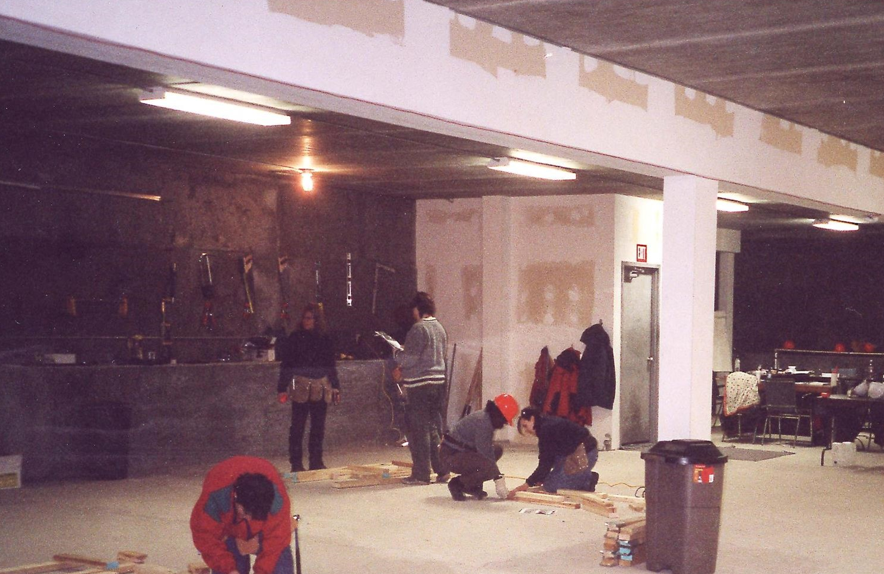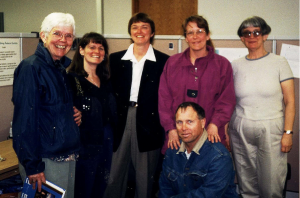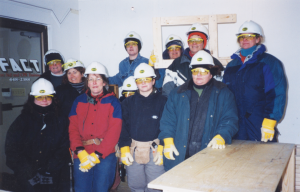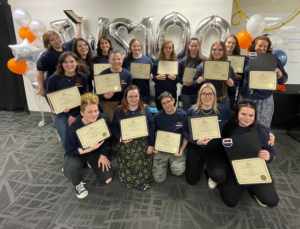Providing the tools to get a start in the trades

- Published On
- September 1, 2023
Jenny Kain reflects on how the idea for the Women Building Futures was formed and the difference the non-profit continues to make in the lives of women.
Looking at ways to help unemployed and underemployed women increase their income gave City of Edmonton social workers Jenny Kain and Marcia Tait the spark of an idea for what would become Women Building Futures.
Kain spoke with Women Building Futures about founding the non-profit.
Here are edited excerpts.
On how the idea for Women Building Futures was formed:

I am a social worker by profession. I worked for the City of Edmonton in Community Services and worked with a lot of women who were living in poverty, who were single parents juggling multiple jobs, but never able to make ends meet. They were working at minimum wage, dead-end jobs without any opportunity.
I was leading a project to bring women together to look at what would be beneficial to them in terms of increasing income.
And at the same time, we had a meeting at one of the community centres with Anne McClellan, [former deputy prime minister], and a group of low-income women. We had a really good engaging conversation about why some of these well-paying jobs with lots of opportunities are not being accessed by or are not available to women. Would women be interested in these? What would be needed? So that was one stimulus.
Another colleague of mine in Community Services, Marcia Tait, was doing some work with what used to be called Capital Region Housing. They were looking to make improvements to some of their properties. We were talking about whether this was an opportunity for people with lower income seeking employment.
That was in 1996, 1997.
Then we started doing research and looked at whether there were other programs available across the country for women in non-traditional trades. We found a women’s construction program that we really liked in Regina [the Regina Women’s Construction Cooperative] and then started building our vision for what we could have here in Edmonton.
We pulled together some additional partners: the YWCA, Mill Woods P.A.T.C.H. Place and Edmonton Women in Trades and Technology. And then we brought on Monika Wichman as our evaluator [to track the impacts of the program from an early on].
[Pictured above, Jenny Kain, second from left, with Monika Wichman, Elizabeth Martian and Marcia Tait, 1998.]
On the Women Building Futures early programming:
 We were successful in getting funding and started with a 20-week program. We partnered with Alberta Vocational College, now Norquest, around the initial delivery in 1999 and 2000, before we moved to offer our own program, which at the time was the 3-week Journeywoman Start.
We were successful in getting funding and started with a 20-week program. We partnered with Alberta Vocational College, now Norquest, around the initial delivery in 1999 and 2000, before we moved to offer our own program, which at the time was the 3-week Journeywoman Start.
We hired Elizabeth Martian, a journeyperson carpenter, as our project coordinator and she developed this 3-week Journeywoman Start [pictured right, the first cohort of the program in 2001]. We had a partnership with this group called FACT First Aid and CPR Training. We wanted to offer women several concrete safety tickets to put them on a bit more of an equal playing field as some of their male counterparts.
[The 3-week carpentry construction job readiness program was taught by 2 journeywoman carpenters and covered hand and power tool safety, standard first aid, Workplace Hazardous Materials Information System, forklift operator safety, skid-steer loader safety, scaffold safety and fall protection, as well as job-site tours, resume writing, job search assistance and working as a woman in the trades.]
On the idea of a construction co-op:
The other original idea was to also have a women’s construction co-op. We had a series of meetings to look at organizing the co-op and invited tradeswomen to participate. We heard clearly from the students as they were doing the training that to think about developing a business at the same time was too much. We also heard that it would be better for the women to get experience in the industry and that we would also pave the way for more positive changes and involvement of women in the trades if women worked with existing companies. So that’s the route we went.
On the City of Edmonton’s role as an incubator:
The City of Edmonton really played a critical incubation role in starting Women Building Futures. For the first 2 years or 3 years of our operations, the Women Building Futures’ office was in our [Community Services] office. They used our reception. All the applicants came there. We hosted information sessions.
On the impact of the Women Building Futures’ programs:
We wanted to track the impacts of the program from early on, the social return on investment. Starting in 1996, we followed women who took the program for 2 years. We looked at the impact it had on their lives and for their kids’ lives.
We were thrilled with the difference it made on women’s lives – women who had been working dead-end and low-paying jobs, with no real hope of getting off social assistance. And you know, it wasn’t for everyone, but some women just thrived.
Before starting Journeywomen Start, slightly more than half the women were employed in service or sales sector. Two years later, 90% were working in the trades. The average hourly wage increased from $11 an hour to $21.20 an hour, almost doubling the hourly wage in 2 years.
Income more than tripled over 2 years, with average employment income increasing from $1,120 to $3,857 a month.
I remember one woman talking about the difference it made for her daughter and how important it was for her daughter to see her in this work, feeling so good about it and feeling proud of the work she did.
On breaking barriers for women in the trades:
That was a big challenge early on, for sure – discrimination against women in certain trades – but gradually, they [employers] came to see how incredibly valuable it was to have women on their teams.
On hiring JudyLynn Archer, WBF’s founding president and CEO:
It was a turning point when we hired JudyLynn. You need different things at different phases in the development of an organization, and she was definitely what we needed to move Women Building Futures forward at that point in time to ensure it was successful. She had a vision and the ability to grow Women Building Futures and take it further, and we needed that kind of leadership. She forged some great partnerships with industry.

On Women Building Futures at 25:
It actually still makes me emotional. I’m just so happy. Everything we hoped to accomplish is being accomplished.
It advances so many goals – in terms of women’s equality, which was so really important to me, and offering another option for women who were working dead-end and low-paying jobs to have a career that could make ends meet.
[Pictured left, the 100th graduating class of our flagship trades exploration program, Journeywoman Start, now known as Journey to Trades, 2023].
On the people who helped launch of Women Building Futures:
We had an incredible group of people. Leaders who were committed to the vision at the beginning. We brought in partners from the Y (Kelly Sloan) and P.A.T.C.H. Place (Shari-Lynne Gidyk) and Women in Trades and Technology in the early days. When we hired Elizabeth Martian – she was very helpful in developing the program. We worked a lot of hours and people contributed a lot beyond their paid employment role. They just were always there and always willing to help and support.
